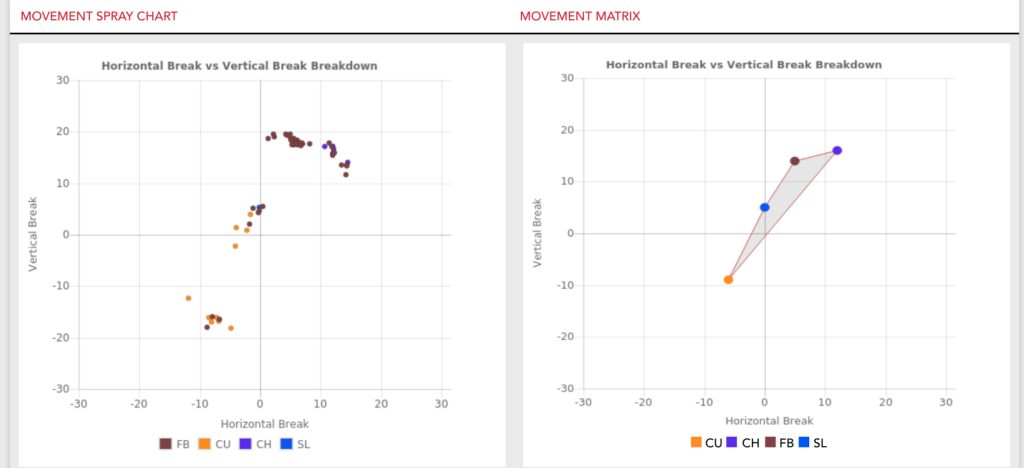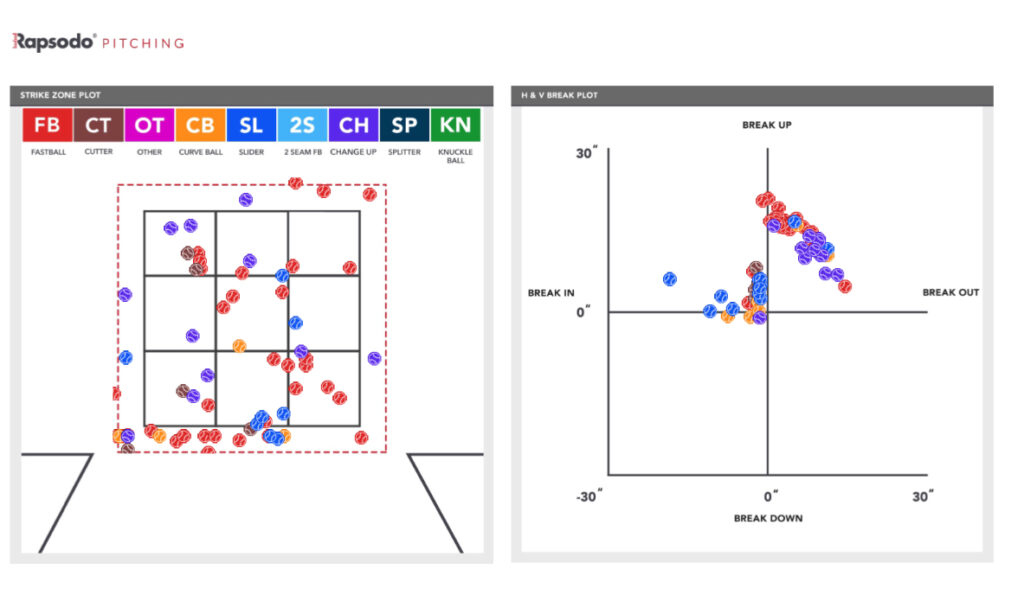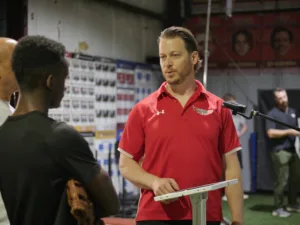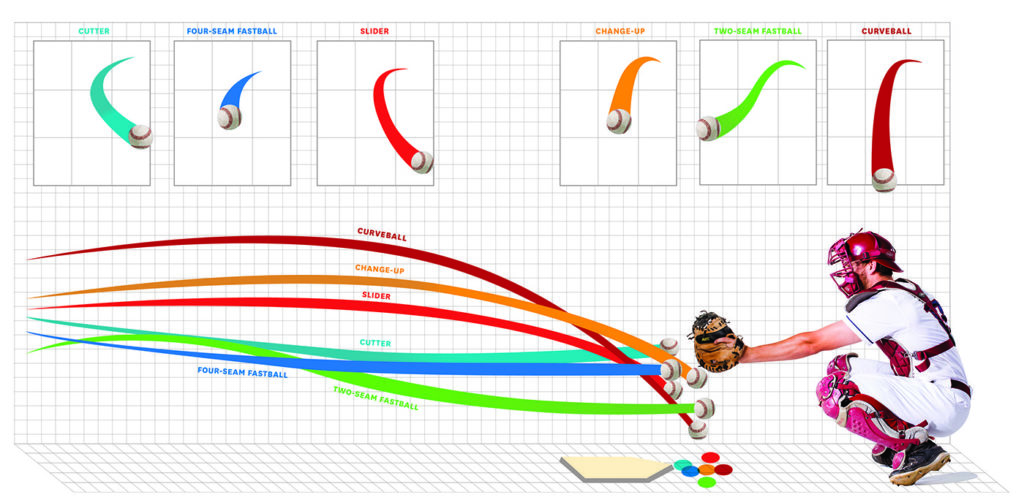 In the world of competitive baseball, precision and strategy are paramount along with Optimizing Breaking Balls. Advances in technology such as Rapsodo, TrackMan, and Yakkertech have revolutionized how pitchers and coaches approach the art of pitch design, particularly when it comes to breaking balls. This comprehensive guide explores the science behind optimizing breaking ball shape through data-driven techniques, aiming to enhance performance and strikeout rates.
In the world of competitive baseball, precision and strategy are paramount along with Optimizing Breaking Balls. Advances in technology such as Rapsodo, TrackMan, and Yakkertech have revolutionized how pitchers and coaches approach the art of pitch design, particularly when it comes to breaking balls. This comprehensive guide explores the science behind optimizing breaking ball shape through data-driven techniques, aiming to enhance performance and strikeout rates.
The Evolution of Breaking Balls
- Historical Perspective: Breaking balls have always been a pitcher's secret weapon. Historically, the quest has been to maximize sweep, depth, and velocity. Today's technology has allowed us to refine these pitches to unprecedented levels.
- Technological Advances: The integration of high-tech tools has provided pitchers with real-time data on spin rate, trajectory, and velocity, transforming pitch training from an art to a precise science.
Breaking Ball Spectrum: Understanding the Types
 The Cutter: The cutter or "cut-fastball" combines the velocity of a fastball with the movement of a slider. It is known for its sharp, horizontal movement and is a popular choice among pitchers for its unpredictability and speed.
The Cutter: The cutter or "cut-fastball" combines the velocity of a fastball with the movement of a slider. It is known for its sharp, horizontal movement and is a popular choice among pitchers for its unpredictability and speed. The Slider: Adjacent to the cutter, the slider breaks laterally and is typically thrown with a blend of backspin and sidespin. Its ability to deceive hitters makes it a staple in any pitcher's repertoire.
The Slider: Adjacent to the cutter, the slider breaks laterally and is typically thrown with a blend of backspin and sidespin. Its ability to deceive hitters makes it a staple in any pitcher's repertoire. The Curveball: With the most dramatic downward movement, curveballs are thrown to dive beneath bats, making them highly effective against aggressive hitters.
The Curveball: With the most dramatic downward movement, curveballs are thrown to dive beneath bats, making them highly effective against aggressive hitters.
Optimizing Each Pitch: Analyzing Movement and Velocity

- Understanding the Mechanics of Each Pitch: Breaking balls, such as cutters, sliders, and curveballs, each bring a unique element to a pitcher’s arsenal. The key to mastering these pitches lies in understanding their distinct movement patterns and velocity characteristics. Advanced pitching technologies like high-speed cameras and radar devices help dissect these pitches in terms of spin rate, release angle, and velocity decay over distance.
- Data-Driven Analysis: By utilizing data analytics tools, pitchers can examine the detailed mechanics of their throws. This analysis includes how the grip, wrist angle, and release point affect the ball’s trajectory. For instance, slight modifications in the grip of a slider can alter its lateral movement, thereby increasing its deception.
- Customizing Pitches to Maximize Effectiveness: The ultimate goal of analyzing movement and velocity is to tailor each pitch to exploit the batter's weaknesses. By adjusting pitches based on comprehensive data, pitchers can enhance the effectiveness of each throw, ensuring that the breaking balls not only move sharply but also complement their overall pitching strategy.
Trade-offs and Adjustments: The Art of Balancing Pitch Design

- Understanding Trade-offs: Improving one characteristic of a breaking ball often requires concessions in another area. For example, increasing the spin rate of a curveball for more dramatic drop might reduce its velocity, making it potentially easier to hit if the location isn’t precise. Understanding these trade-offs is crucial for developing an effective pitch.
- Balancing Velocity and Movement: The challenge lies in balancing velocity, movement, and pitch predictability. Pitchers must experiment with different techniques during practice sessions to find the optimal balance that suits their style and game strategy. Using tools like Rapsodo, pitchers can get instant feedback on how changes affect the pitch's behavior, allowing them to make informed adjustments.
- Strategic Adjustments for Game Situations: In-game adjustments are also vital. Pitchers need to continuously analyze the game situation, batter tendencies, and their own performance. If a pitcher notices that batters are starting to time their curveball effectively, they might decide to tweak the pitch's velocity or movement subtly to regain the upper hand.
- Collaborative Efforts Between Pitchers and Coaches: Collaboration with pitching coaches and analysts is essential. These professionals can provide insights derived from data analytics to suggest modifications that a pitcher might not consider. This teamwork helps in fine-tuning pitches not only based on the pitcher's capability but also based on strategic game planning against specific teams or batters.
By understanding and implementing these aspects of pitch optimization, pitchers can elevate their game, making each pitch more precise and challenging for batters to handle.
Case Studies and Applications: Optimizing Breaking Balls
Major League Insights: Harnessing MLB Data for Pitch Enhancement
- Leveraging High-Tech Tools: In Major League Baseball, the use of advanced analytics and technology to refine pitching techniques is becoming increasingly common. Technologies such as high-speed cameras, 3D motion capture systems, and ball tracking devices like Statcast offer detailed insights into how pitches behave during a game.
- Specific Case Examples: For instance, a Dodger Pitcher made an adjustment to his curveball illustrating the practical application of these technologies. By analyzing release point data and spin axis information gathered during games, this pitcher and his coaches identified a slight inconsistency in his grip and release that was causing less effective breaks. Adjustments were made in training sessions, monitored by the same technologies, to enhance the consistency and deadliness of his curveball.
- Visual Data Representations: Graphical analyses often show a pitch’s movement in three dimensions, allowing pitchers and coaches to understand subtle differences between effective and less effective pitches. These visualizations can compare a pitcher’s throws against league averages or show changes over time, providing clear targets for improvement.
Practical Applications: Integrating Data-Driven Insights into Training

- Routine Incorporation of Technology: Pitchers at all levels can benefit from incorporating technology into their training routines. Even basic video analysis can provide insights into mechanics and help identify areas for improvement. More sophisticated tools, like wearable sensors, can give feedback on arm angle, force application, and spin rate.
- Training with Purpose: Using data to inform training means more than just collecting numbers; it means analyzing the data to create targeted practice sessions. For example, if a pitcher discovers that their slider is most effective at a certain spin rate, they can focus drills on replicating the grip and wrist action that achieves this spin.
- Feedback Loops: Creating a feedback loop is crucial. This means regularly collecting data, analyzing it, making adjustments, and then collecting new data to see the effects of those adjustments. This cycle helps pitchers continuously improve based on empirical evidence rather than guesswork.
- Accessibility for Non-Professionals: For non-professional athletes, simpler and more accessible technologies, like smartphone apps that analyze video to provide basic data on pitch speed and trajectory, can still significantly impact training outcomes. These tools make it possible for pitchers at lower levels to engage in data-driven training previously only available to top-tier athletes.
By understanding these applications and integrating these strategies, pitchers can not only improve their current skills but also set a foundation for continual growth and adaptation in their pitching careers.
Advanced Metrics and Models: Optimizing Breaking Balls

Predictive Modeling: Optimizing Breaking Balls
Understanding the Role of Predictive Models
Predictive modeling in baseball utilizes a combination of historical data, player-specific metrics, and advanced algorithms to forecast pitch outcomes. These models are particularly adept at analyzing how variations in spin rates and arm angles affect a pitch's trajectory and effectiveness.
Components of Predictive Models
- Spin Rate Analysis: By examining the spin rate of a pitch, models can predict its movement. For example, a higher spin rate on a curveball generally results in a sharper break, making the pitch more difficult for batters to hit.
- Arm Angle Dynamics: The angle at which a pitcher releases the ball significantly influences its path. Predictive models use data from multiple pitches to determine optimal arm angles for achieving desired pitch movements.
- Environmental Factors: Factors such as air density and weather conditions are also integrated into models to refine predictions. This holistic approach ensures that recommendations are realistic under various playing conditions.
Application in Player Development
Teams and coaches use these models to tailor training programs for individual pitchers, focusing on adjusting techniques that align with the predictive outcomes. This targeted approach helps pitchers develop their skills more efficiently and effectively.
Visualization Techniques: Enhancing Decision-Making with Advanced Software
The Power of Visualization in Coaching
Modern software provides sophisticated visualization capabilities that can simulate how a pitch will move even before it's thrown. These visual tools are invaluable for both coaches and players, providing a clear, intuitive understanding of pitch dynamics.
Key Visualization Techniques
- Trajectory Simulation: Software can graphically represent the flight path of a pitch from the moment it leaves the pitcher's hand to when it crosses the plate. This allows pitchers to see the theoretical outcome of perfecting certain mechanics.
- Heat Maps: Visual heat maps show areas where a pitcher's throws are most effective or where they tend to lose control. This spatial analysis helps in strategizing pitch locations against different batters.
- Comparative Analysis: Side-by-side comparisons between a pitcher’s intended pitch and the actual outcome help in identifying discrepancies that need correction.
Enhancing Training Sessions
Incorporating these visualization tools into training sessions enables pitchers to experiment with adjustments in a controlled environment and see immediate results. The ability to visualize changes in real-time helps solidify the learning process, making it easier to replicate successful pitches during games.
Bridging Theory and Practice
Visualization not only helps in understanding complex data but also bridges the gap between theoretical knowledge and practical application. By seeing an abstract concept like spin rate translated into a visual format, pitchers can intuitively grasp how changes to their technique can lead to different outcomes on the field.
Through the use of advanced metrics and models along with sophisticated visualization techniques, pitchers and coaches can gain a deeper understanding of pitching mechanics and make informed decisions that enhance performance and strategic planning.
TopVelocity Pro Pitch Analytics
 Elevate your pitching game to major league standards with Top Velocity's Pro Pitching Grips Analytics! Whether you're struggling to nail the perfect pitch combination or your current pitches lack effectiveness, our advanced analysis is the solution you need. We offer individual pitch analysis, opportunities for improvement, major league pitch grading, and much more.
Elevate your pitching game to major league standards with Top Velocity's Pro Pitching Grips Analytics! Whether you're struggling to nail the perfect pitch combination or your current pitches lack effectiveness, our advanced analysis is the solution you need. We offer individual pitch analysis, opportunities for improvement, major league pitch grading, and much more.
Don't let progress stall. Get a detailed breakdown of your pitching grips and ball release using high-speed video analysis. With just a minimum of three pitches of each type, recorded at your average or peak velocity, we can provide a comprehensive analysis that includes data analysis and video insights to refine your arsenal and set you on a road to success.
Visit Top Velocity Pro Pitching Grips Analytics today to get started. Let our expert analysis be your ace in the hole and transform your pitching performance!
Act now and take the first step towards optimizing your pitching skills with the most advanced baseball pitching grips analysis available!
Conclusion: Optimizing Breaking Balls
The ongoing evolution of pitch design promises even more precise and effective pitching strategies. As technology advances, so too will the methods we use to train the next generation of elite pitchers.
FAQs: Optimizing Breaking Balls
- What is a breaking ball?
A breaking ball is a type of pitch in baseball that deviates from a straight trajectory due to its spin. - How does technology influence pitch design?
Technology like Rapsodo and TrackMan provides real-time data that helps pitchers optimize the shape, speed, and spin of their pitches. - Can any pitcher learn to throw effective breaking balls?
Yes, with proper training and access to pitch design technology, pitchers at all levels can improve their breaking balls. - What are the common mistakes when designing a breaking ball?
Common mistakes include overemphasizing velocity at the expense of movement, or not accounting for the individual pitcher's mechanics. - How often should pitchers practice their breaking balls?
Consistent practice is key, but the focus should be on quality and data-driven feedback rather than quantity.
For more exclusive content visit TopVelocity Patreon!


 The Cutter: The cutter or "cut-fastball" combines the velocity of a fastball with the movement of a slider. It is known for its sharp, horizontal movement and is a popular choice among pitchers for its unpredictability and speed.
The Cutter: The cutter or "cut-fastball" combines the velocity of a fastball with the movement of a slider. It is known for its sharp, horizontal movement and is a popular choice among pitchers for its unpredictability and speed. The Slider: Adjacent to the cutter, the slider breaks laterally and is typically thrown with a blend of backspin and sidespin. Its ability to deceive hitters makes it a staple in any pitcher's repertoire.
The Slider: Adjacent to the cutter, the slider breaks laterally and is typically thrown with a blend of backspin and sidespin. Its ability to deceive hitters makes it a staple in any pitcher's repertoire. The Curveball: With the most dramatic downward movement, curveballs are thrown to dive beneath bats, making them highly effective against aggressive hitters.
The Curveball: With the most dramatic downward movement, curveballs are thrown to dive beneath bats, making them highly effective against aggressive hitters.

Trackbacks/Pingbacks